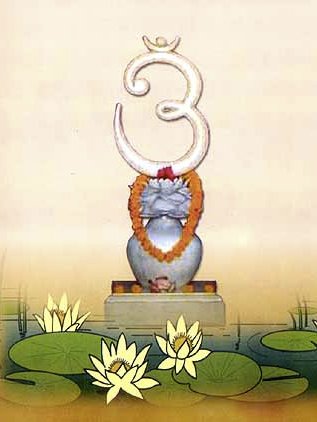Parables of Rama
by Swami Rama Tirtha | 102,836 words
Stories in English used by Swami Rama to illustrate the highest teaching of Vedanta. The most difficult and intricate problems of philosophy and abstract truths, which may very well tax the brains of the most intellectual, are thus made not only simple and easy to understand but also brought home to us in a concrete form in such an interesting and ...
Story 205 - The Story of Lord Shiva & Bhasmasura
Lord Shiva (the light of the Seed-body) once gave a boon to the demon Bhasmasura that anything on which he would place his hand will be burnt to ashes. On getting this power, he wanted to try it on Lord Shiva Himself. Realizing this, Shiva ran away from the demon. But the demon would not let Shiva go. He continued to chase Him (Shiva). It appeared that the demon was sure to catch hold of Shiva and destroy Him. But will he really destroy Him?
While the Devil Bhasmasura was running after Shiva, there appeared on the scene an extremely beautiful and charming young girl, smiling and dancing in various poses. It was Lord Vishnu, the light of Satva guna, who adopted the form of this charming young girl to save Shiva). The demon fell in love with and was attracted towards her.
She was dancing rapturously. Her dance was so rhythmical and infectious that the demon also could not help dancing with her. He was, as if, one with her in the dancing poses. While dancing, the girl raised her hands and made semi circles. The demon also did the same. Gradually, while dancing, she put one of her raised hands on her head and the demon also copied her in his infatuation and state of self-forgetfulness. And lo! No sooner did he put his hand on his head, than he was burnt to ashes.
The lesson from this allegorical story is as follows: As the sun shines on the snow, a river is created. So, too, when the sun of Atman (Shiva) shines on seed body steeped in inertness, Bhasmasura (the Vagrant mind) is born. As a matter of fact, there is nothing but Atman (Shiva) but due to the power bestowed by Atman, the vagrant mind (Bhasmasura) can destroy anything. There is Atman (Shiva) in front of you when Bhasmasura (vagrant mind) cast its shadow, it looked a tree. The Atma so to say, disappeared from there or ran away from there. What is to your right? It is Atman (Shiva). When Bhasmasura (vagrant mind) cast his shadow, it looked a wall. The Atman, as it were, vanished. But Atman cannot be killed on any account. Even in the names and forms of the tree, the wall, Atman is being expressed by its nature, Existence, Knowledge and Bliss. (Sat, Chid, Anand). What is towards your head? It is Atman. When Bhasmasura cast its shadow, it looked a moon. Atman, as if, disappeared. Atman is all pervading. There is nothing but Atman, everywhere. But wherever the demon Bhasmasura puts his hand (the mind exercises its influence) it all becomes dead carcass, matter of name and form. The reality, Atman, is not seen then.
From childhood till your old age, whatever you heard or did in sleep or waking state was all Atman, but the mind (Bhasmasura) could not see Atman anywhere.
According to Sanskrit Astrology, the same sun in different houses is named differently. Similarly, the same Atman is called differently in different states. In deep sleep state, it is called Shiva, because it enlightens the seed-body. In the waking state it is called Vishnu, because it enlightens the waking state. In order to subdue Bhasmasura (vagrant mind) this Atman (Vishnu) in the waking state, with excess of Satva guna or virtuous conduct, adopts the form of a charming girl to sing Divine songs. This means that the Divine songs of Upanishads make the vagrant mind enter into a state of self-forgetfulness. The teaching of the Upanishads makes you dance at her tune. And, when you are completely won over, she places her hand on her own head i. e. assures you with a vow that you are nothing but God. At this moment, Bhasmasura also puts his hand on his head to indicate his conviction that he is also God. This means that mind's vagrancy is destroyed. It becomes peaceful and it merges into Atman. This is the realization of the Self. At this stage all ego is gone and nothing remains except God and God alone.
